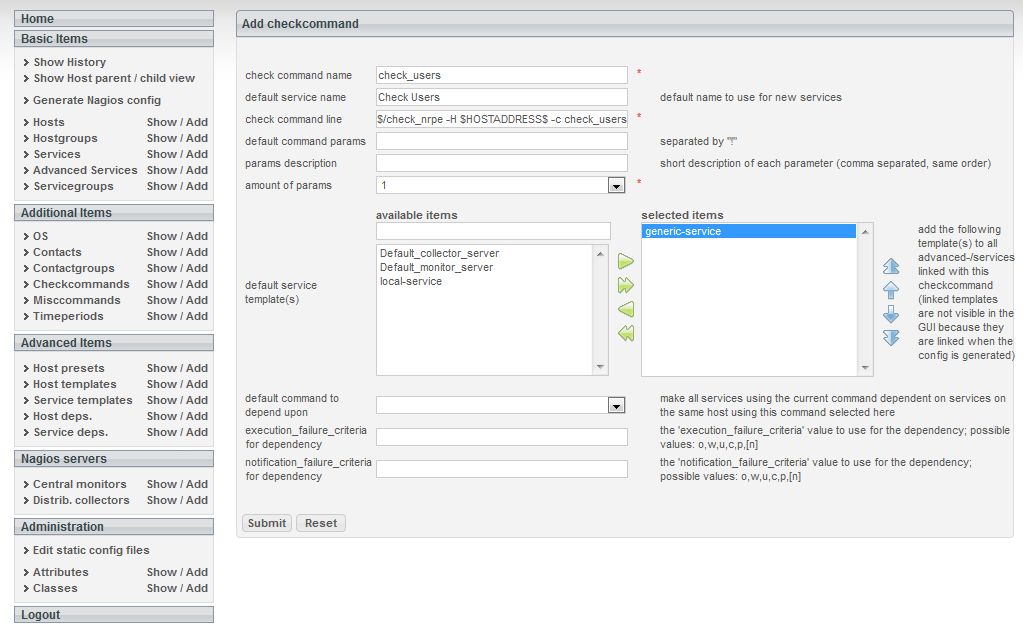
Remote machine configuration: Create a new nagios user and assign a password.
/usr/sbin/useradd nagios
passwd nagios
Download and extract nagios plugins
wget https://www.nagios-plugins.org/download/nagios-plugins-1.5.tar.gz
apt-get install libssl-dev
tar zxvf nagios-plugins-1.5.tar.gz
cd nagios-plugins-1.5
Compile and install the plugins.
./configure --with-nagios-user=nagios --with-nagios-group=nagios
make
make install
Plugin permissions need to be fixed, so run these commands.
chown nagios.nagios /usr/local/nagios
chown -R nagios.nagios /usr/local/nagios/libexec
Installs the NRPE daemon as a service on xinetd.
apt-get install xinetd
wget http://sourceforge.net/projects/nagios/files/nrpe-2.x/nrpe-2.15/nrpe-2.15.tar.gz
tar zxvf nrpe-2.15.tar.gz
cd nrpe-2.15
./configure --with-ssl=/usr/bin/openssl --with-ssl-lib=/usr/lib/i386-linux-gnu/
make all
For 64bit users:
ln -s /usr/lib/x86_64-linux-gnu/libssl.so /usr/lib/libssl.so
./configure
make all
Install the NRPE plugin (for testing), daemon, and the daemon config file examples.
make install-plugin
make install-daemon
make install-daemon-config
Install the NRPE daemon service on xinetd.
make install-xinetd
Edit the file /etc/xinetd.d/nrpe and add the IP address of the server where Nagios is installed in the only_from section.
only_from = 127.0.0.1 <nagios_ip_address>
Save and exit
:wq
Add this line for NRPE daemon to /etc/services
nrpe 5666/tcp # NRPE
Save and exit
:wq
Restart xinetd service
service xinetd restart
Test NRPE locally Make sure NRPE daemon is running under xinetd
netstat -at | grep nrpe
The output should be something like this:
tcp 0 0 *:nrpe *:* LISTEN
Configuration in Nagios Machine:
Install NRPE plugin on the machine where nagios is
wget http://sourceforge.net/projects/nagios/files/nrpe-2.x/nrpe-2.15/nrpe-2.15.tar.gz
tar zxvf nrpe-2.15.tar.gz
cd nrpe-2.15
./configure --with-ssl=/usr/bin/openssl --with-ssl-lib=/usr/lib/i386-linux-gnu/
make all
make install-plugin
for 64bit users:
ln -s /usr/lib/x86_64-linux-gnu/libssl.so /usr/lib/libssl.so
./configure
make all
make install-plugin
Test communication between the host machine and the remote machine.
/usr/local/nagios/libexec/check_nrpe -H <ip_address_remote_machine>
The output should look like this:
NRPE v2.15
Configure Nconf with NRPE commands (some of them) In the file /usr/local/nagios/etc/nrpe.cfg you can see these lines:
#Check current users
command[check_users]=/usr/local/nagios/libexec/check_users -w 5 -c 10
#Current Load
command[check_load]=/usr/local/nagios/libexec/check_load -w 15,10,5 -c 30,25,20
#Root Partitions
command[check_sda1]=/usr/local/nagios/libexec/check_disk -w 20% -c 10% -p /dev/sda1
#ZombieProcesses
command[check_zombie_procs]=/usr/local/nagios/libexec/check_procs -w 5 -c 10 -s Z
#TotalProcesses
command[check_total_procs]=/usr/local/nagios/libexec/check_procs -w 150 -c 200
#SwapUsage
command[check_remote_swap]=/usr/local/nagios/libexec/check_swap -w 70% -c 90%
Before using check_disk make sure you have the right path to /dev/xxx as in the example:
df -h
Filesystem Size Used Avail Use% Mounted on
/dev/sda1 109G 18G 86G 17% /
Configure Nconf to use NRPE: In the Nconf menu click on ADD in the checkcommands option and write

check command name: check_users
default service name: Check Users
check command line: $USER1$/check_nrpe -H $HOSTADDRESS$ -c check_users
Default service template: generic_service
Then click on submit.
Now the command is ready to be added as a service in one of the machines to monitor.



Use the share button below if you liked it.
Your click is my virtual high-five.